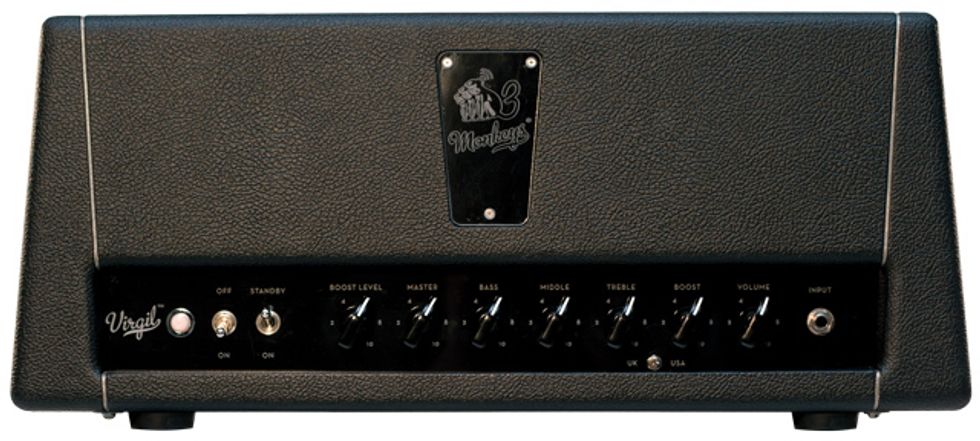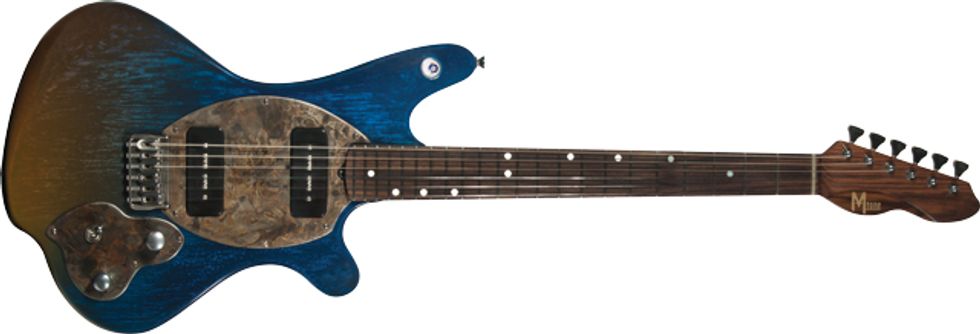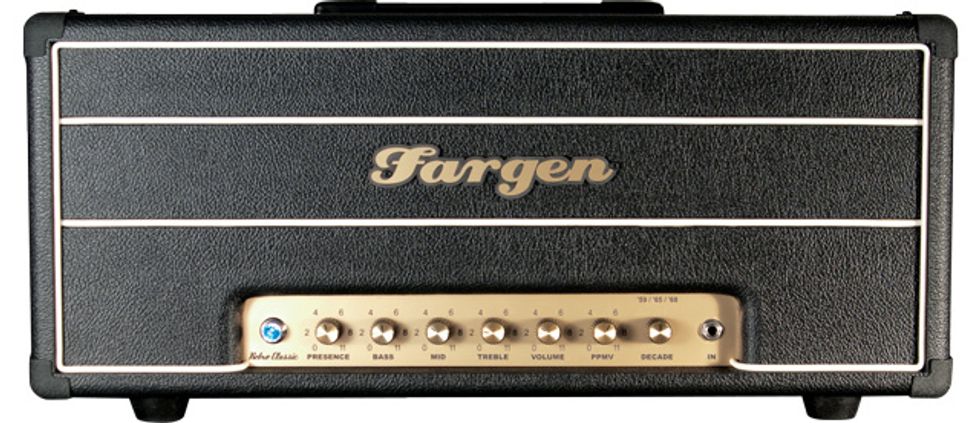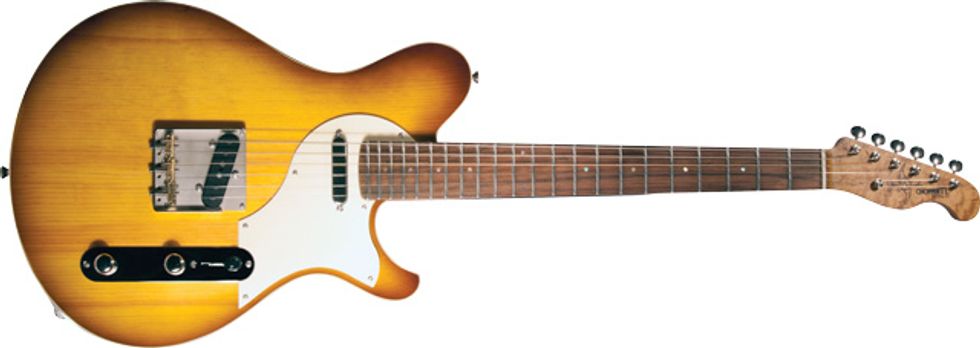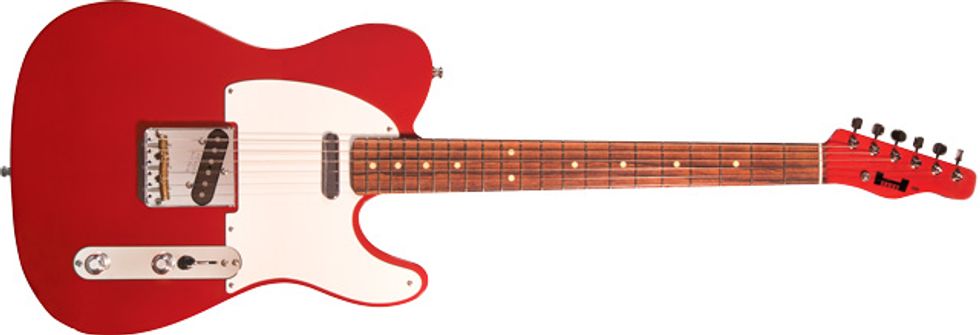Meet the 41 guitars, basses, amps, and effects that blew our minds this year with their fantastic tones, innovative features, and all-around awesomeness.
When it rains it pours. That’s what we learned while assembling the roster for this year’s Premier Gear Award winners. After all, this glut of gear goodness meant we tickled our ears—well sometimes pummeled our ears—with tones dulcet, dangerous, daring, and delectable. It also means that you, faithful reader, will be swimming in possibilities—which is a damn good thing when it comes to making music. Traditionalist, futurist, minimalist, maximalist … no matter where you fall on the guitar geek chart, you owe it yourself to test-drive at least one of the instruments or gadgets among the winners’ ranks. Heck, we think you should try ’em all. So rip it up, readers—let those furious notes fly. This is the crème de la crème of 2012, and it’s there for the pickin’!
Verellen Meatsmoke
January 2012
READ THE FULL REVIEW
While the Verellen Meat Smoke’s odd moniker and charred visage conjures thoughts of feasting on brisket and pulled pork, the heavyas- heck sounds lurking within this 300-watt monster are more mouth watering than the biggest Memphis BBQ banquet. Like the Marshall Major and Sunn Coliseum back in the ’70s, the Meatsmoke is equally suited for guitar or bass, and the six 6550 power tubes will give any player enough headroom to shatter glass with sweet clean tones. But it also has an overdrive channel that generates heaps of midrange grunt and grind that will spin the heads of metal fiends and stoner rockers out to do major damage. In our review, we suggested it might be the best new amp on the market for doom rock, sludge metal, and postrock players for whom massive volume is an essential musical texture. And though that may remain a subjective assertion, you can be certain the Meatsmoke will be too beautifully deafening for you to hear anyone arguing the point. verellenamplifiers.com
3 Monkeys Virgil
February 2012
READ THE FULL REVIEW
Born from a brain trust cofounded by Aerosmith’s Brad Whitford, Greg Howard (guitar tech for Aerosmith and Green Day), and former Blockhead Amps mastermind Ossie Ahsen, Virgil is a 30-watt, two-channel, 6V6-powered amp designed to deliver a cool hybrid of Hiwatt and Marshall tones, as well as a menu of blackface Fender tones. With its articulate character and surprising amount of headroom, we found it unsurprising that highly particular players like Steely Dan’s Walter Becker have turned to this elegant Swiss Army Knife of tone. And the trapezoidal, Marshall-meets-AC50 styling is about as cool looking as they come. We found the Virgil to be equally capable of beautiful, high-headroom clean tones and blistering overdrive. And that capacity for being an amp for all occasions for so many players made it impossible to not bestow a Premier Gear award to this lovely simian sound machine. 3monkeysamps.com
Echopark Downtowner Custom Koa Limited
March 2012
READ THE FULL REVIEW
Gabriel Currie is a veritable whirling dervish of guitar-building energy, and that energy has sustained a career in lutherie that spans four decades and includes stints with G&L and Hosono Guitar Works. Given that, it might come as a surprise that his Downtowner is a guitar of such sedate design, a synthesis of Supro and Les Paul Jr. that’s understated enough to seem anonymous—at least until you pick it up and play. The hefty, C-profiled koa neck and mahogany body make the Downtowner feel rock solid and stable. And the PAFspec’d, handwound Amalfitano humbuckers ooze burly, late-’50s humbucker vibes and a range of strong mids, round lows, and bristling high end that knocked our socks off. echoparkguitars.com
Carvin Brian Bromberg B24P Signature
March 2012
READ THE FULL REVIEW
Jazz bass giant Brian Bromberg has gigged with enough legends—Stan Getz, Dizzy Gillespie, and Bill Evans—to know a great bass sound and how to get it. So it’s little wonder the Carvin Brian Bromberg signature bass delivers so extraordinarily on so many levels. The 8.8-pound, 34"-scale hot rod of a 4-string proved exceptionally comfortable and playable with its neck-through design. And the range of tones lurking within its dramatically styled body is enormous, thanks in large part to its super-flexible EQ section and Carvin’s own RJ2 alnico single-coils, which can be blended with an onboard piezo pickup. When combined with active circuitry, the output from the Carvin proved refined and focused. And while it probably wouldn’t be a metalhead’s go-to bass, just about any other type of player that values nuance and warm detailed tones will savor the possibilities of this shapely Carvin. carvinguitars.com

Lollar Pickups El Rayo Humbuckers
March 2012
READ THE FULL REVIEW
Few names in the aftermarket pickup trade carry the clout of Jason Lollar. The bearded madman from the Northwest is renowned for both dead-on vintage reproductions as well as inspired and original evolutions of the classics. And the list of builders and players that make his pickups integral to their own designs and sounds reads like a roll call of the guitar elite. Given all that, it makes perfect sense to see the El Rayo among this year’s Premier Gear award winners. The El Rayo takes on the ambitious task of delivering P-90-punch and girth from a humbucker and succeeds in spectacular fashion—serving up throaty, focused, super-present tones along with extraordinary pick sensitivity and response. lollarguitars.com

TC Electronic PolyTune Mini
March 2012
READ THE FULL REVIEW
Needless to say, pedal tuners don’t rank too high in the glamour sweepstakes, so when one comes along that does that simple and essential job a little bit better, we tend to take notice. For one thing, the PolyTune Mini is really, truly small—1.7" x 3.7" x 2", so it’ll fit even the most crowded pedalboards. Depending on your current tuner pedal, switching to the Mini very well may free up enough room to bring out some other stompbox you’ve been keeping out of the mix for space reasons. But size is only part of the story here. The new PolyTune software—which is most notable for its polyphonic capabilities—also features new settings for polyphonic capo and dropped-D tuning. It ain’t easy to make a tuner sexy, but TC Electronic’s PolyTune Mini definitely gets us a bit worked up. tcelectronic.com
BiLT S.S. Zaftig
April 2012
READ THE FULL REVIEW
Is it just us, or does it seem like you could rule the guitar-playing universe with a guitar called the S.S. Zaftig? There’s no doubt that BiLT’s most beastly axe feels and looks mighty formidable, and the Iowa-based luthiers were clearly inspired by some classic guitars from Southern California when they put this hefty semi-hollowbody together. But the payoff comes when you realize its tones are as fat as the guitar itself. The semi-hollow construction combined and Lollar Regal humbuckers (Lollar’s take on the Seth Lover-designed Fender Wide Range humbucker) give it a sound that leans more toward the Gibson SG or ES-335 side of the tracks than anything traditionally Fender. What the S.S. Zaftig does uniquely well is deliver a very Fender-like playability and expressive potential, thanks to the cool, Jaguar-style vibrato unit, Mastery bridge, and comfy neck profile. But it also serves up a Telecaster Custom/SG-style muscularity that makes everything from Chicago blues to experimental open-tuned droning sound monstrous and unique. biltguitars.com
M-Tone Slipstream
April 2012
READ THE FULL REVIEW
Matt Proctor was a sculptor before he became a luthier, and one look at the Slipstream tells you that this is an instrument more-or-less unencumbered by the styling dogma that often plagues the electric guitar universe. But the Slipstream is more than an exercise in styling originality. As its presence among this year’s Premier Gear winners suggests, this is a superb all-around instrument that, despite its outward originality and break from tradition, pays tribute to the ingenuity of the space age. With Lollar P-90s (yes, there they are again), a handcarved pao ferro neck, and a mahogany body, the 25 1/2"-scale Slipstream is an interesting convergence of boutique materials and Fender and Gibson tonalities—though that proved too simple a formula to describe the capabilities of this instrument. Reviewer Dimitri Sideriadis noted how easily the guitar moved from Zeppelin-esque and Live at Leeds heaviness to clean, lean, and complex funkiness. Sideriadis also said, “you just might feel inspired to take musical leaps you might not have taken with a more traditional guitar,” adding that, “the pickups, balance, and playability just inspire confidence.” Sounds like a ticket to interesting territory to us. m-tone.com
Fender Johnny Marr Jaguar
May 2012
READ THE FULL REVIEW
Fender’s Jaguar is too quirky to earn the level of popularity enjoyed by the Tele or Strat—near-perfect guitars that work for beginners and masters alike. But for the Jag faithful, its perceived design shortcomings have always been a world of possibilities. Johnny Marr, who favors cool chords and textures and almost never plays a solo, is certainly among those ranks. While the design optimizations on his signature Jaguar certainly make it more friendly to players appalled by the original’s unusual bridge and difficult-to-decipher switching array, it’s still an impressive platform for sonic adventurism. The pickup switching is still complex, but it’s also practical—it includes parallel/series options, and the latter enables brawny humbucker tones if you so choose. The Bare Knuckle pickups are gorgeous sounding. The neck pickup is capable of some of the most complex Fender single-coil tones you’ll ever hear. With a vibrato arm that actually stays secure and a Mustang-style bridge, this might be the best-playing Jaguar yet. But fear not adventurers—a whole world of weird still lurks within. fender.com
Fargen Retro Classic
May 2012
READ THE FULL REVIEW
Vintage Marshall clones are far from uncommon, but packing so much, well, Marshall-ness into a head with just 25 watts of oomph isn’t something you see or hear every day. Ben Fargen, however, is a connoisseur of all things Marshall, and with his beautiful KT66-powered Retro Classic celebrates the style and substance of ’60s-era Marshalls as well as the ties that bind the earliest Marshalls to Fender’s tweed heritage. In addition to the flexibility that comes from a more manageably sized Marshall-type amp, the Fargen stoked us with a cool and practical 3-way voicing switch that transforms the amp from a very late-’60s-styled plexi-inspired voice to a mod-era JTM-45 sound and a squishier tweed Bassman-like personality. We found precious few drawbacks to exploring these typically very big voices in a less-deafening package, and a small loss in high-end pick articulation was about the only one. Otherwise, the Retro Classic is classically Fargen—ingenious, reverent, and built to last an eternity. fargenamps.com

Jackson Ampworks Newcastle
June 2012
READ THE FULL REVIEW
Simplicity can be a rather daring gesture. It can also paint you into a corner. But in the case of Jackson Ampwork’s diminutive, 18-watt, EL84-powered Newcastle, simplicity is paradoxically the ticket to an expansive tone landscape. With just volume and tone knobs, the Newcastle is streamlined enough that a three-toed sloth on cough syrup could dial in a sweet tone. But as our reviewer Dimitri Sideriadis discovered, those tones can range from mellow and rich jazz colors to classic-rock crunch—with a strong midrange and a tight bottom that make up a sweet and versatile baseline voice. The Jackson also exhibited a knack for classic EL84 chime that works well for country and folk-rock textures. And with its piggyback configuration dressed up in copper-and-crème vinyl, the Newcastle has few contenders when it comes to looking sharp. jacksonampworks.com
Jason Z. Schroeder Chopper TL "T-Pine"
June 2012
READ THE FULL REVIEW
Jason Schroeder’s wraparound bridges and unique guitars have helped the up-and-coming luthier build a reputation for top-quality axes and parts. But it’s guitars like the beautifully built Chopper TL “T-Pine” that could establish Schroeder’s identity as an out-of-the-box-thinking traditionalist. The pine body isn’t just handsome in a cool, almost downhome, American-high-craft way, it’s also a vehicle for a stunning range of sounds—from archetypal Tele tones to a midrange-rich and almost- Gibson-like harmonic muscularity. The Lollar pickups provide an airy, complex voice, delivering tones that move from rude to civilized. But reviewer Dimitri Sideriadis summed up the T-Pine’s classic-meets-modern attributes best when he said, “though much of the Chopper T-Pine’s success is attributable to Schroeder’s knack for taking the best from proven platforms, judiciously chosen tweaks, styling twists, and a penchant for quality and tone make the T-Pine a very special guitar.” Sounds like a recipe for success to us—and a great reason to watch Jason Schroeder in the years to come. schroederguitars.com
Fender Select Telecaster
July 2012
READ THE FULL REVIEW
How do you improve an electric-guitar design that was born almost perfect? Even if you’re the company that built the original, which Fender did back in 1949, making a truly, measurably better Telecaster is no mean feat. With the Select Telecaster, however, Fender successfully refined what’s arguably the classic electric-guitar design without sacrificing any of the design elegance or intrinsic beauty that made the Telecaster an article of mid-century design genius. While some purists may blanch at the flamed-maple top—which definitely looks a bit flash on a Telecaster—the Select Tele is unquestionably handsome and manages to look deeply luxurious without being ostentatious. Other breaks from tradition are a little more practical, like the belly cut, a chambered body that keeps the weight under eight pounds, and a compound-radius fretboard that’s great for fleet-fingered leads. But the Select Telecaster also proved a versatile and refined beauty that could range from open and up-front with the no-load tone knob engaged, or civilized and refined in jazzier situations. Who says you can’t top perfection? fender.com

J. Rockett Audio Designs Alien Echo
July 2012
READ THE FULL REVIEW
Call it echo. Call it delay. But by any name this very simple phenomenon of audio physics can engender a whole lot of debate among guitar slingers. Modern, icy, and clean? Smoky, warbly, and imperfect? J. Rockett’s Alien Echo is clearly designed to accommodate the predilections of players that savor the hazy, modulating repeats of tape echo. But this digital circuit can just as easily help you sculpt crystalline and precise echoes. Better yet, the cool, two-footswitch layout lets you move between the two worlds in a flash. The random modulation function is organic and expressive sounding, moving reviewer Dimitri Sideriadis to praise its “gorgeous, watery character.” But we had a ton of fun exploring its more radical and otherworldly side, its wonderful dynamic sensitivity, and even its mellowing effect on bright pickups. It’s a delay that not only does a lot, but it’s also one that doesn’t require you to pick a side in that great digital/analog divide. rockettpedals.com
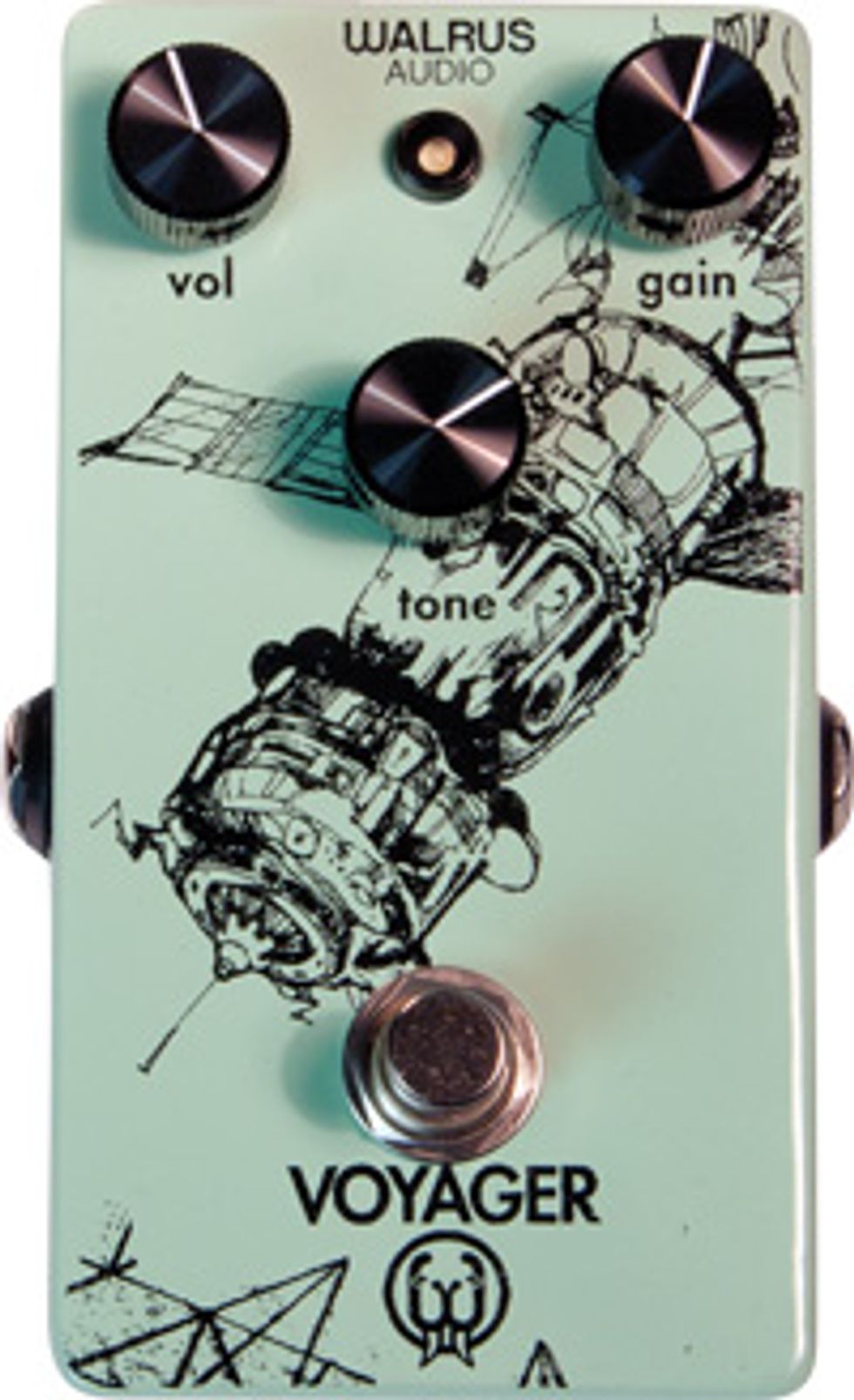
Walrus Audio Voyager
July 2012
READ THE FULL REVIEW
As our reviewer Tyler Green noted, space travel and the search for tone are not that dissimilar—with both, there’s a lot of glamour, fire, flames, sonic booms, and money shots. But behind the fireworks, utility reigns supreme. With an image of a Soyuz spacecraft adorning the enclosure, the Walrus Audio Voyager overdrive acknowledges both sides of the tone equation with a beautifully nuts-and-bolts affair that lends its own subtle but lovely colors. In the crucible of a weeklong tour, Green found the Voyager capable of superb note articulation that enabled him to cut through cluttered stage mixes. It demonstrated an uncommon knack for bringing out the best in other pedals, and even in the most basic overdrive applications, the Voyager added worlds of harmonic complexity and richness to otherwise pedestrian amp tones. So while the Voyager might not make you a master of interstellar, sonic madness, it might just become the foundation of a great tone from which you can venture much further afield. walrusaudio.com
AXL USA Bulldog AL-1090
August 2012
READ THE FULL REVIEW
We’re used to giving Premier Gear awards to products that are exquisite, rare, and—for many of us—financially out of reach. So it’s a joy when we get to reward an instrument that delivers so much in terms of vibe and value. And if that’s your measure of a great guitar, the AXL Bulldog may be this year’s reigning champ. At just about 550 bucks, the Bulldog—which, incidentally, is assembled in Music Link’s Hayward, California, facility—is a beautifully bare-bones budget wonder. Despite the bargainbasement price, it’s still bristling with top-quality components like Kluson tuners and CTS pots, as well as smart features like a push-pull pot that bypasses the tone circuit. But as reviewer Jordan Wagner found, it’s what this gorgeously simple axe does plugged in that will you leave you slack jawed. Wagner found the clean tones “powerful and, at times, stunningly detailed” and was repeatedly surprised by the clarity and sparkle. In more aggressive settings, the Bulldog was no less surprising, delivering classic P-90 punch and harmonically rich growling tones. Handsome, tough, sleek, and cheap. Heck, why not buy two? axlguitars.com
Fractal Audio Axe-FX II
August 2012
READ THE FULL REVIEW
Dweezil Zappa knows a thing or two about electric guitars and how to make them sound extraordinary. So when he declared to us at the L.A. Amp Show that the new Axe-FX II was “the greatest invention ever for electric guitarists,” our interest was piqued (not that we wouldn’t have been paying attention anyway). The original Axe-FX was an amazingly powerful application of digital modeling and effects processing. This version, however, uses twin Tiger SHARC processors to pump out insanely detailed models of the most desirable amps and effects—and all with stunningly realistic touch sensitivity and playing dynamics. It also has incredibly cool features like tone matching that enable you to sample the performance characteristics of a favorite amp. Joe Charupakorn remarked that, “what it offers practical and adventurous players alike in terms of sonic potential is hard to put a price on.” And even though the Axe-FX II far from cheap, we’d be inclined to agree. fractalaudio.com
Hahn Model 1229
August 2012
READ THE FULL REVIEW
There are few things more beautiful in the guitar galaxy than a beautifully executed T-style electric. And since Leo Fender cast the die 60 years ago, perhaps no modern luthier has built a finer T-style than Chihoe Hahn. Like all of Hahn’s work, the 1229 is deeply reverent of Leo’s genius, but the 1229 deviates from the classic T-style template with a few moves more aligned with Gibson’s world—and those deviations are a big part of what makes this guitar extraordinary. The relatively thin mahogany body is based on an old Melody Maker, of all things, and the mahogany neck adds another measure of Gibson flavor. Despite these Gibson-inspired elements that sometimes add up to some extra heft, the Hahn is also surprisingly light. And the tonewood recipe and classic T-style design elements—including brass saddles and a 25.5" scale—add up to a fantastically resonant guitar that’s everything from bright to jazzy and super responsive. Looks mighty fine in red, too, wouldn’t you say? hahnguitars.com
Deimel Guitarworks Firestar
September 2012
READ THE FULL REVIEW
So many guitars now play off retro templates that it’s hard to tell where the substance starts and style ends. But the Deimel Firestar not only unites a fairly original take on Firebird and Jaguar design cues and exacting quality, but also adds some very contemporary features with fascinating musical potential. The combination of hot Novak P-90s, a compact body, a substantial neck, and a cleverly cool Duesenberg vibrato makes it the kind of guitar that can turn a single, screaming sustained note into a musical voyage. And the bevy of pickup-switching options—including series and parallel settings and a piezo pickup—mean this might be the only guitar you need to pack for a gig for a long time to come, whether you’re a free-form experimentalist or roadhouse rock player. Looking backward never felt so totally futuristic. deimelguitarworks.de
Kemper Profiling Amplifier
September 2012
READ THE FULL REVIEW
As we noted in our review for the Kemper Profiling Amplifier, doit- all amps have been promising the world for … well, it seems like forever. But the Profiler’s approach to being all amps to all people comes through very different means: It samples the sonic signature of your favorite amp and adds powerful tone-sculpting tools to the equation. With the Profiler, you can sample and store not just your own favorite amps, but sample the sound and performance attributes of, say, that ’68 plexi that your best friend laughs in your face about when you ask if you can borrow it for a gig. It also facilitates cool stage scenarios where you can switch between not just the usual suspects you hear in most modeling amps, but positively eclectic and bizarre models. Virtually any amp you can slap a mic in front of can potentially become part of your tone palette. And if you think we’re not going to use this thing to power a solo that moves between a decrepit old solid-state Vox with built-in fuzz and a cherry Princeton, well, you don’t know us very well ... kemper-amps.com
Ritter R8 Singlecut
September 2012
READ THE FULL REVIEW
Jens Ritter has a nose for the finer things—just watch our Ritter shop tour video at permierguitar.com to see what we mean—but he also possesses a sense of exactitude befitting a semiconductor specialist (which he used to be). The convergence of those forces results in instruments like the R8 Singlecut bass—which reviewer Dave Abdo says, “excites the inner scientist and unlocks unlimited creativity from the artist.” The luxurious R8’s body is carved from a single piece of gorgeous flamed maple, and cool touches like ebony pickup covers, a custom brass bridge, triplebuckers (one passive coil and two active coils), and the clever EQ system make the bass an incredible and highly tailorable tone machine. Abdo also found the Singlecut incredibly responsive and balanced, remarking that he could actually feel an ingenuity at work in the bass’ design that reduced fatigue and enhanced techniques. Abdo was moved enough by the R8 to say that the term “art” did not do Ritter’s work justice. If the music that comes out of the R8 is half as inspired as that, it’s worth its weight in gold. ritter-basses.com
Ernie Ball/Music Man Game Changer
October 2012
READ THE FULL REVIEW
The ambitious Music Man Game Changer dares to ask what shapes the marriage of analog and digital can take in an electric guitar. The answer, we found out, was “Just about freaking anything, from a tone perspective”—and that was enough to justify bestowing a Premier Gear award. But we might not have been so inclined were the Game Changer just a gimmick. It’s not. It’s a guitar designed to open up as many combinations of a simple pickup array as possible via digital control. And that philosophy of making the most from a little is one that’s all right by us. Detractors, needless to say, will call it overkill, but we’re inclined to applaud the possibilities of it all. And while the technology might fail to impress players who just want to flick a simple switch and rock, guitarists who relish the micro-nuances of tone will have a field day. And if that describes your musical philosophy, the Game Changer will be worth every penny. music-man.com

Wren and Cuff Box of War
October 2012
READ THE FULL REVIEW
The original Sovtek Big Muff—known far and wide as “the Civil War”—is about as cool looking as pedals come, and it goes without saying that the sound was legendary. Both points serve as the inspiration for Wren and Cuff’s Box of War—a fantastic-sounding, Civil War-inspired fuzz by any measure. But it’s Wren and Cuff’s decision to dress the pedal up in a sturdy, sweet-looking enclosure—which apes the Civil War’s graphic while employing a sort of compact Super Fuzz enclosure design—that makes it all a little more special. The Box of War practically beckons you to stomp, and the payoff when you do is bound to soothe the soul—and stoke the creative fires—of any player who’s ever thrilled to the growling menace and smooth cello tones of a Big Muff. Gear editor Charles Saufley applauded the Box of War’s uncommon penchant for string-to-string detail and harmonic richness, even with chords. It might be a bit too civilized for players who savor the gnarliest Muff tones, but it’s still destined to be one of the classiest and coolest-sounding pedals on any pedalboard at your next gig. wrenandcuff.com
Fano Alt De Facto PX4
October 2012
READ THE FULL REVIEW
If you have a certain type of design eye—one that relishes the collision of guitar design and mid-century furniture design—Gibson’s non-reverse Firebird and Thunderbird basses are slices of jet-minimal- modernist perfection. Luthier Dennis Fano seems devotedly of that school of thought, but his ability to understand the merits of these instruments clearly goes deeper—into realms where a wellworn specimen of the order can deliver musical magic. We found the PX4 to be about as playable as a bass can be, and we were doubly stoked that behind the PX4’s quasi-vintage exterior lurked a 16-position switch that expands the already impressive tone potential of the Lollar pickups. But what the Fano does best is deliver the kind of thumping, authoritative, smooth, warm tones that defined rock’s golden era. Add an overflowingly bossy vibe, and you have a 4-string that borders on irresistible. fanoguitars.com

Wampler Tweed '57
October 2012
READ THE FULL REVIEW
Brian Wampler is already known as a master of replicating amp dynamics with a stompbox, but we all know it still ain’t easy tackling the complex, compressed, squishy-to-exploding tones of a tweed Fender. One of the most beautiful things we discovered about the Tweed ’57 is that, despite having a mission to capture such a specialized and difficult-tonail voice, it works beautifully with tube amps of all types, in addition to solid-state amps. And it can lend an extra measure of tone, EQ, and, dynamic capabilities that can genuinely expand the voice of a tube amp that has started to sound dull. Reviewer Joe Charupakorn remarked that it’s “the kind of pedal that can save your hide when you have to gig in rooms of varying size, or when you’re dealing with a questionable backline.” In other words, the Tweed ’57 gives you more of just about whatever you need—whether it’s jangle or organic crunch—depending on how you use the gain control, input simulator switch, and 3-band EQ. Even if you’re not dead-set on the sound of tweed, the Wampler can still add a whole lot of character and life to your rig. wamplerpedals.com
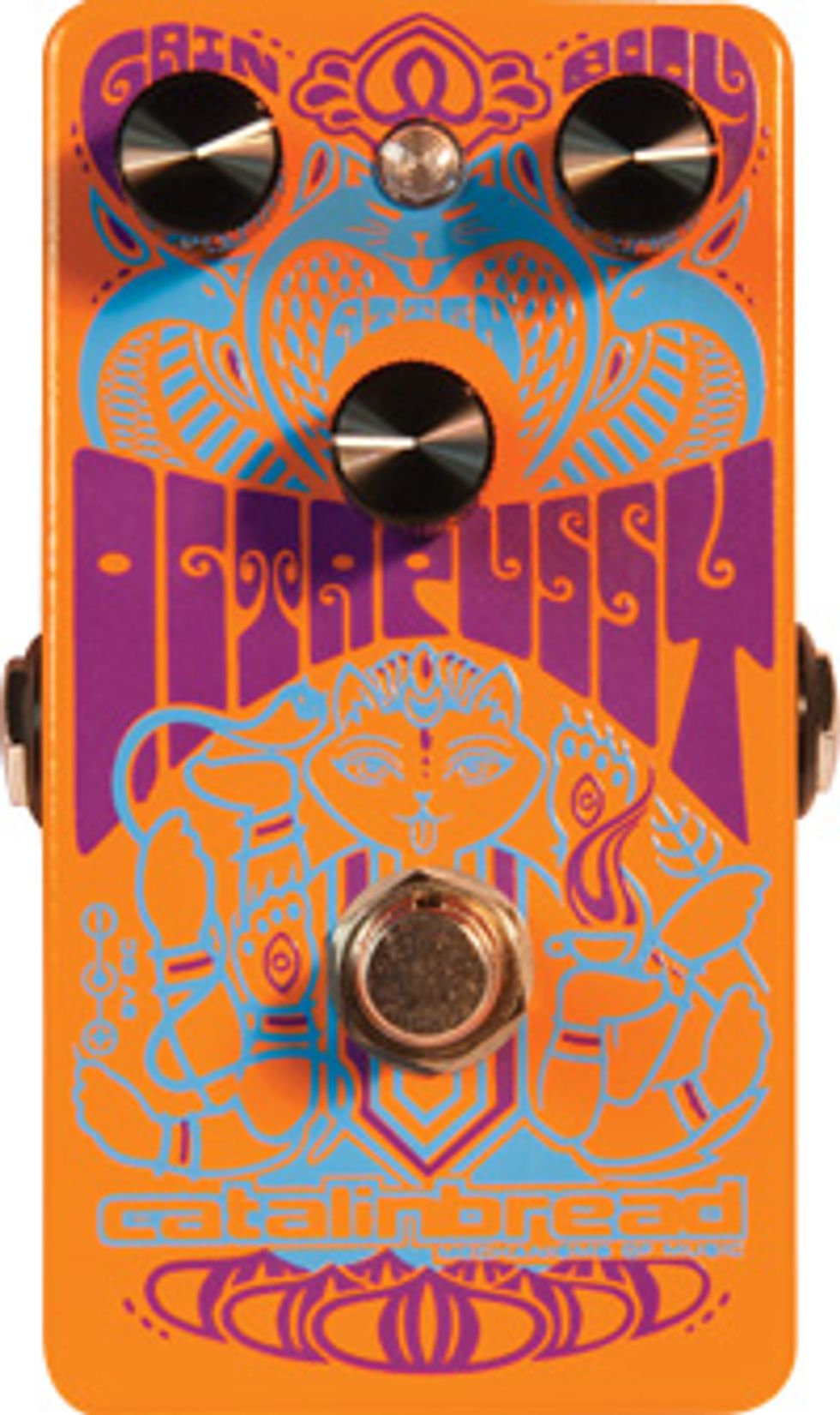
Catalinbread Octapussy
October 2012
READ THE FULL REVIEW
Octave fuzz adds attitude to a lead like few other effects. It’s sassy, it’s funky, but it can also strip dynamics from your tone and add unwanted compression that can turn a mix to mud. The Catalinbread Octapussy is designed, to a significant extent, to eliminate those limitations. But in the process it becomes an octave fuzz of varied voices and broad capabilities. Most notably, it’s highly reactive to adjustments from a guitar’s volume and tone controls. We found the Octapussy capable of some classic ring-modulator effects, but we were even more impressed with how much sustain and yummy decay the Octapussy generated at less-than-full-bore levels. Overall, we found the Octapussy to be a big leap forward in terms of musicality and range. Best of all, we found it to be a path to unexpected octave effects. Pretty cool for an effect that tends to be stereotyped in terms of tone and application—and it’s also clear evidence of why builders keep tinkering with these circuits. catalinbread.com
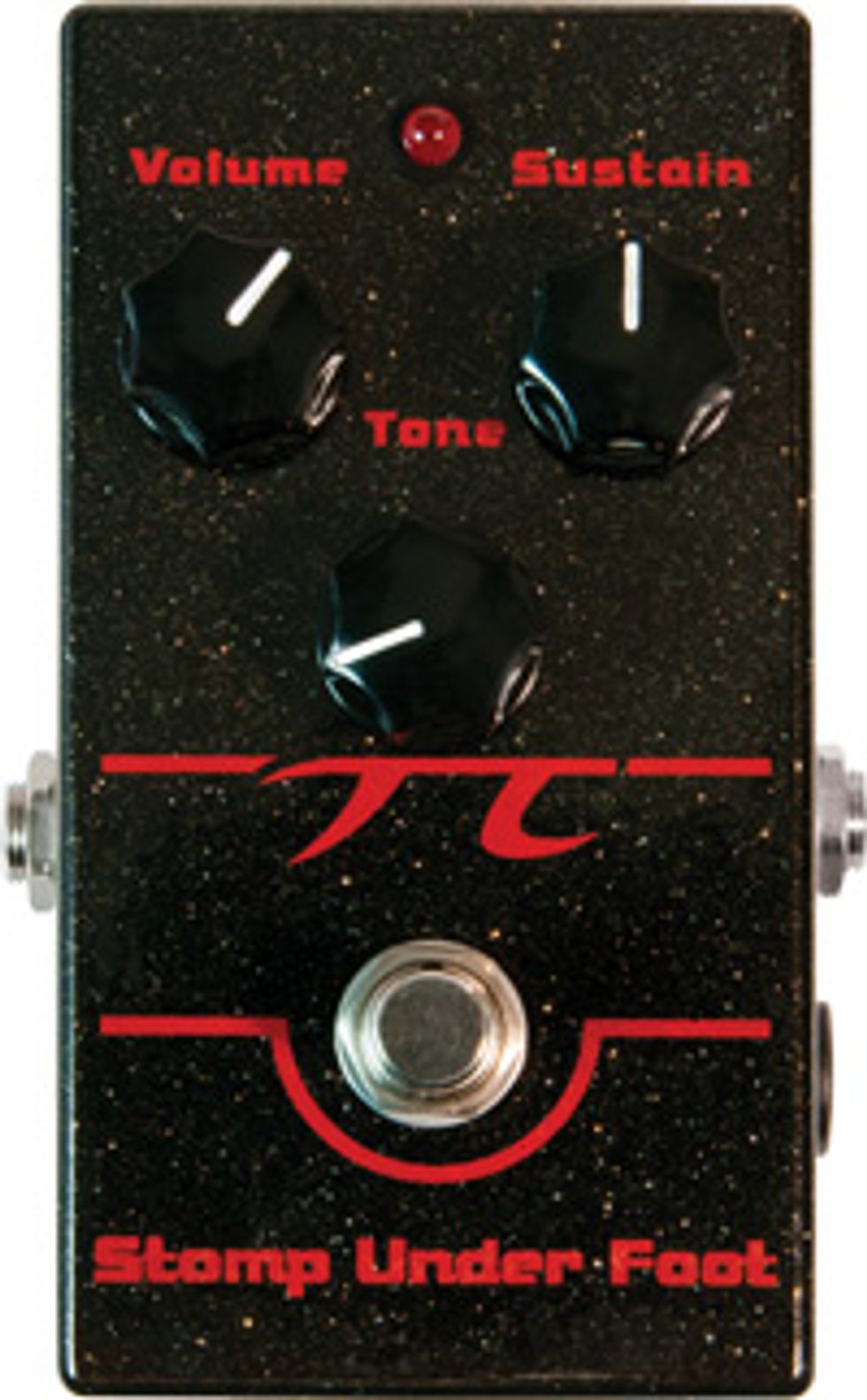
Stomp Under Foot The Pi
October 2012
READ THE FULL REVIEW
Matt Pasquerella has carved out quite a niche building great Muff-style fuzz circuits, and that’s because he has a knack for finding great vintage Muffs and figuring out precisely what makes them tick. The Pi is built around the commonalities found in the latest Ram’s Head Muffs and the visually iconic black-and-red Muffs that are a template for the look of Electro-Harmonix’s current NYC version. It may be the perfect pedal for players who don’t know whether they’re more aligned with the searing sounds of the Ram’s Head or the more corpulent Russian Muffs. The tone knob effectively guides navigation between those two EQ spheres. And in its brighter modes, the Pi proves equally adept at Iommi-like lead tones, detailed power-pop arpeggios, and even raspy ’60s buzz when you roll the volume back and crank the sustain. Throw in the capacity to do all things classically Muff—from singing Gilmour leads to desert-rock crunch—and you’re talking about a genuinely evolutionary take on a circuit that gets more gloriously varied the deeper we dig. stompunderfoot.com
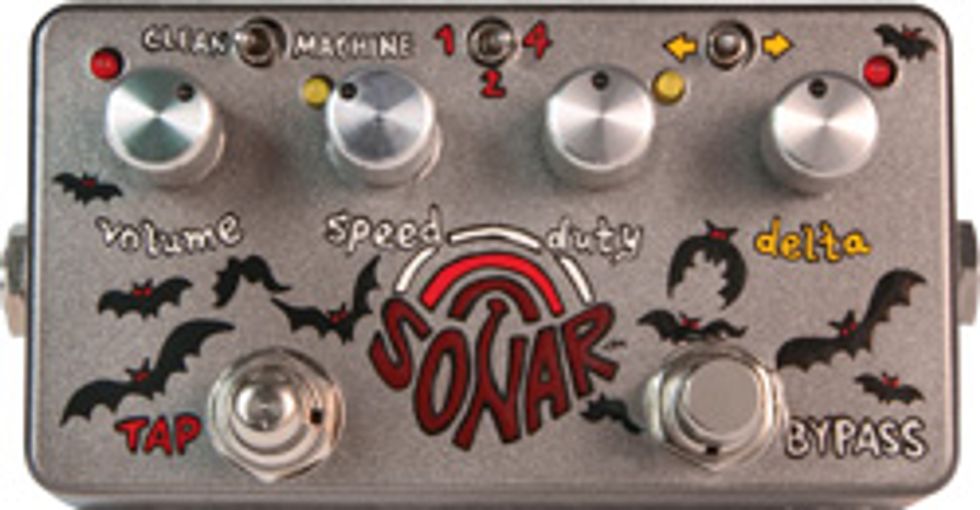
Z. Vex Sonar
October 2012
READ THE FULL REVIEW
Thank goodness for Z.Vex. Every time you think you’ve heard it all, these vanguards and explorers of the boutique-pedal pantheon twist sound on its ear again. In this case, Z.Vex tackles tremolo and, in the process, makes this modulation mainstay better suited for high-gain applications and heavy pulsation. The real beauty of the Sonar, however, is the unexpected ways in which it lets you shape the tremolo effect: A built-in noise gate enables crazily intense pulses at high volumes and distorted settings, while the inclusion of Z.Vex’s infamous Machine circuit adds a crossover distortion effect that can make the tremolo rather more grotesque. And an amazing speed range makes the Sonar even more flexible. We applauded the Sonar’s ability to range from “classic to maniacal.” But like so many Z.Vex pedals, it’s award-worthy because of the way it takes an effect we thought we knew and transforms it into a whole new tool for musical expression. zvex.com
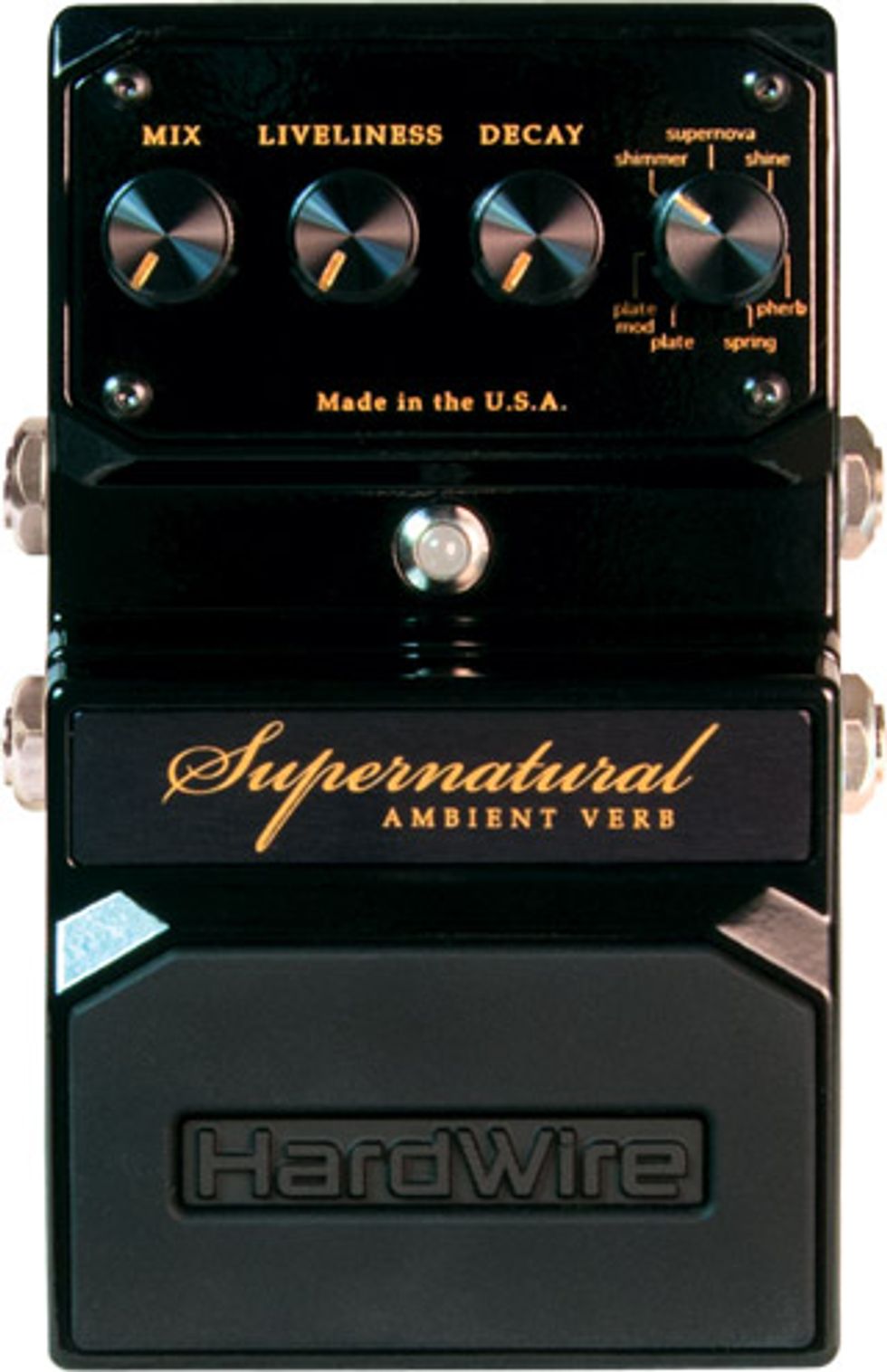
Hardwire Supernatural Ambient Verb
October 2012
READ THE FULL REVIEW
As far as guitar effects go, reverb might be unsurpassed for conjuring moods and emotions. And though spring reverb has long been the gold standard for many reverb-loving guitarists, even a simple stompbox reverb can have transformative power—lending grand, cinematic scale to simple chords and single notes. Apparently, the mission of the HardWire Supernatural Ambient Verb is to pack as many of the most emotive reverb textures as possible into a single compact stompbox. That ambition alone would make the Supernatural a Premier Gear award contender, but it’s the HardWire’s ability to deliver a wide range of simple to soaring reverb that puts it over the top. We found the Supernatural just as capable of subtle vintage-amp-style reverb as it is of wide-as-the-sky ambience. And the rock-solid construction inspires a cool “Yes, I really can pack this much atmosphere on my pedalboard” confidence that’s likely to incite widespread excitement among performing post-rock texuralists, indie bands, and prog obsessives. proguitarshop.com

Strymon Flint
October 2012
READ THE FULL REVIEW
We’ve probably started to sound like a broken record in our praise for Strymon, but the fact is that these guys harness the power of DSP for music-making good like few others out there. Like the company’s El Capistan delay, the Flint Tremolo and Reverb was born out of the effort to nail the minute nuances of analog effects that make them classics. And like the El Capistan, the Flint is truly ambitious in terms of its targets—the vibey-as-heck harmonic tremolo from the Fender 6G5 Pro, a brownface-style tube-bias tremolo sound, and the warm, intense, and psychedelic pulses of Fender’s photocell tremolo. That the Flint nails those textures and enables mix-and-match pairings with three superb, tweakable reverbs—a ’60s-style spring unit, a ’70s-style plate emulation, and an ’80s-style, rack-reverb-like voice— makes this pedal a super-fun and expansive texture playground that could confound the most hardcore analog devotee. strymon.net

T-Rex Tap Tone
October 2012
READ THE FULL REVIEW
With fantastic delays like the Reptile and Replica already in the company’s product line (and with famous players like Carlos Santana, John Mayer, and Pete Townshend endorsing other T-Rex offerings), you might be justified in wondering why T-Rex would bother with adding another delay to the mix. The answer, of course, is the taptempo function that’s the backbone of this pedal. But that’s just part of the story behind this well-built, super-functional box. There’s a bite control that can shift the voice from crystal clear to dirty, warbling, and tape-like, in addition to an essentially warm analog glow that you can hear in just about every setting. Still, it’s the flexibility of its namesake function that’s the real bonus. It enables you to seamlessly and radically shift speeds on the fly, and that gives this T-Rex so much musical potential to walk away with a Premier Gear award. t-rex-effects.com
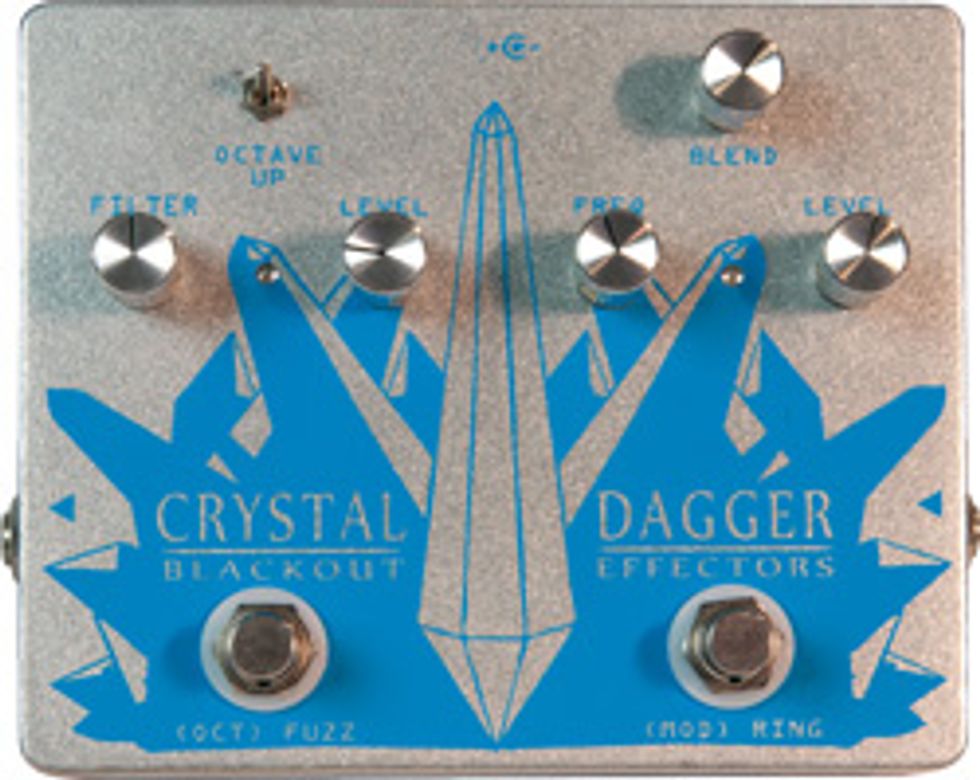
Blackout Effectors Crystal Dagger
October 2012
READ THE FULL REVIEW
We love pedal builders that dabble in the unexpected, the unusual, and the perverse. That impulse—the drive to mess with sound—is what’s made a lot of the greatest pedal builders legendary. And it clearly compelled Blackout Effectors to build the Crystal Dagger—an unlikely combination of octave fuzz and ring-modulation that can be both nastily focused and chaotic. Reviewer Jordan Wagner discovered that the octave fuzz is uncommonly “clean and tight, with smooth lows and mids and a not-too-piercing high end,” with output that “is detailed across the entire tone spectrum [and] makes Hendrix-style leads above the 12th fret sound especially fat.” The ring-modulation function, meanwhile, added everything from ricocheting phase tones and metallic undercurrents to “fantastic beating pulses” at the point where octave and modulation effects begin to blur. In short, the Crystal Dagger is a ticket on a fast train to some very awesome sonic radicalism that gives you the power to unleash a positively deadly octave fuzz tone when you need your solos and riffs to be focused and to-the-point. This is one sharp dagger indeed. blackouteffectors.com
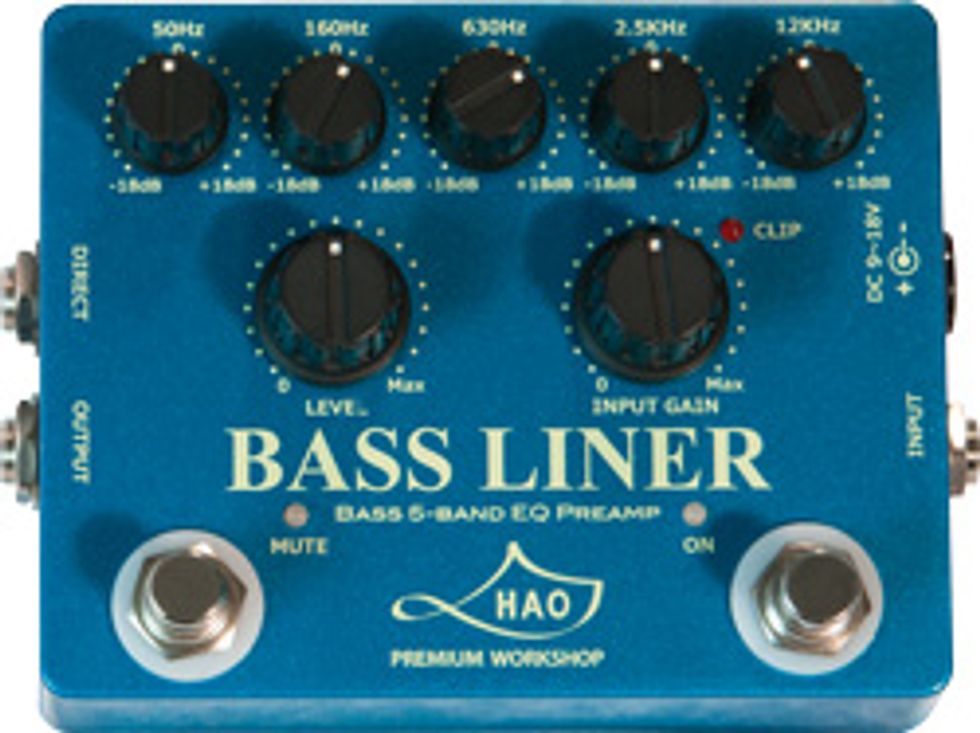
HAO Bass Liner
October 2012
READ THE FULL REVIEW
Reviewer Dave Abdo called the EQ on the HAO Bass Liner preamp “secret spice,” and indeed, this is the kind of box that can help transform your bass tones from the stuff of a greasy spoon’s line chef to complex flavors concocted by a schooled saucier. HAO enlisted the help of bass-amplification guru Phil Jones to hone the Bass Liner, and the fruit of the collaboration is a tool of exceptional quality and formidable tone-shaping power that reviewer Abdo found intuitive and easy-to-use. Chalk it up to that secret spice—an excellent and effective 6-band EQ that enabled him to dial in everything from midrange presence to top-end bite and fat, thumping, dubby low end. Abdo also appreciated the HAO’s capacity to add active pickup-like sensitivity and liveliness to narrow-voiced instruments. For those of us who value the feel and vibe of our most treasured 4-string but need a little extra versatility, the Bass Liner is a potent ally. godlyke.com
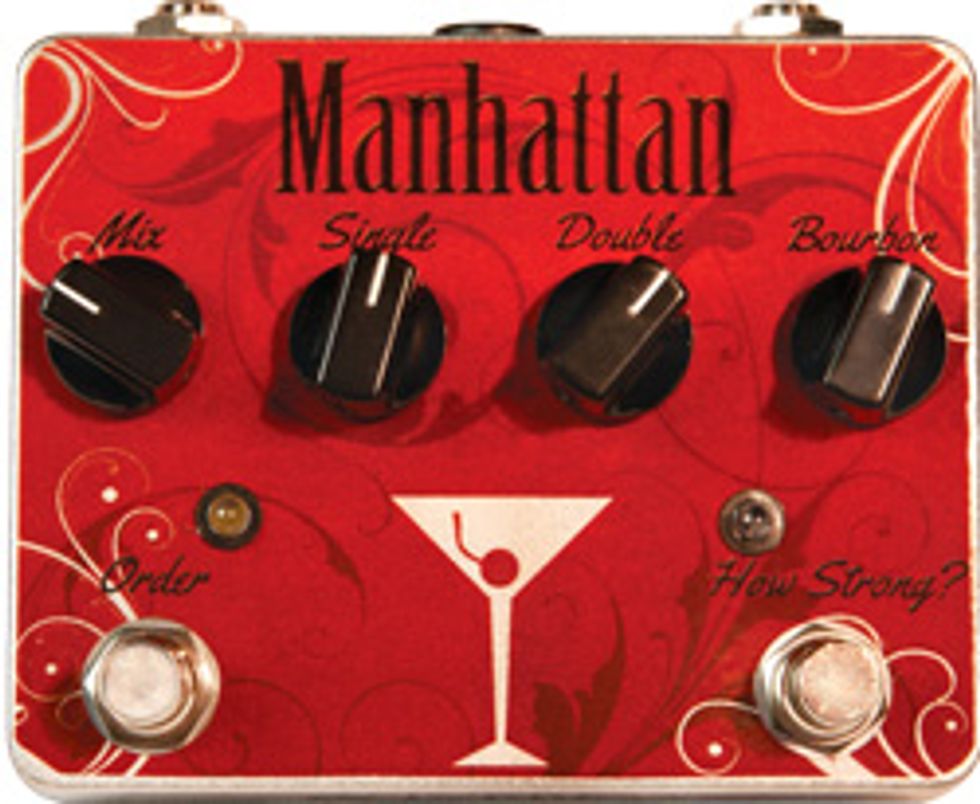
Tortuga Manhattan
October 2012
READ THE FULL REVIEW
You’d be forgiven for being a little frustrated if you were trying to navigate the Tortuga Manhattan for the first time without a manual. Tortuga mastermind Matt Johnson has a playful design sense that leads to controls named “bourbon” instead of “feedback,” for instance. But the fact is that the Manhattan sounds so good in so many ways, it almost doesn’t matter what knobs you twist—or how. And the intuitive approach to tone shaping that this pedal inspires is nothing short of, well … inspiring! That doesn’t mean the Tortuga Manhattan isn’t a completely practical tone-shaping tool. On the contrary—reviewer James Rotondi found it capable of everything from lush and convincing Leslie tones to deep, swooshing flanging and atmospheric chorus tones that proved beautifully musical. Rotondi was moved to remark that the Manhattan was capable of generating “lovely swaths of sound” and remarked on its “smoothness, complexity, and depth.” Sounds worth toasting to us. tortugaeffects.com
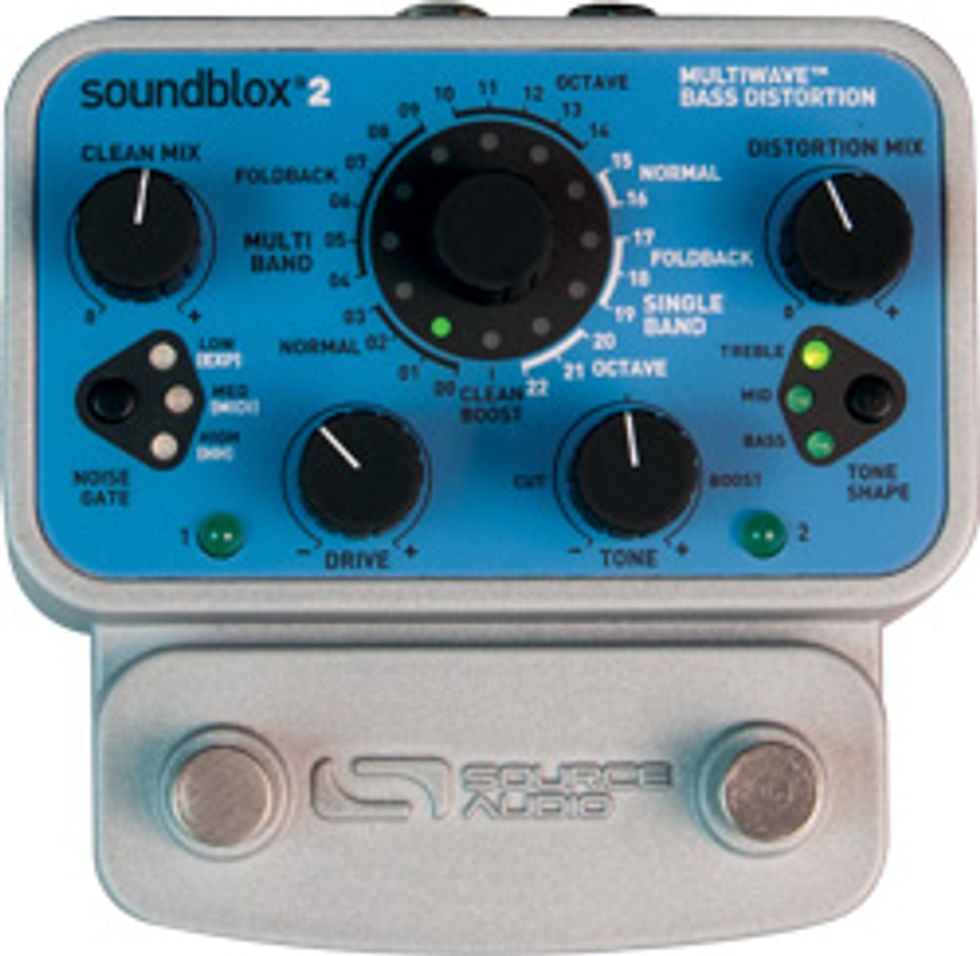
Source Audio Soundblox 2 Multiwave Bass Distortion
October 2012
READ THE FULL REVIEW
Source Audio has always been great at taking the extended and nontraditional potential of the bass guitar very seriously. With the Soundblox 2, they seem hell-bent on a mission to give bass thumpers a piece of the distortion action that guitarists get to enjoy in so many thousands of flavors. And as the 22 distortion settings on this pedal suggest, they’ve delivered in a big way. The big surprises are the multiband settings, which split your signal apart and distort them individually before reassembling your signal into a multi-dimensional whole. You can tap into filter-like tones and synth-y textures and further sculpt your distortion voices using the 3-stage noise gate, the effective tone shape knob, and the simple 4-knob control set for managing signal mix, tone, and drive levels. With the additional benefit of programmable presets, it’s a pedal that can crack your basstone vocabulary wide open. sourceaudio.net
TV Jones Spectra Sonic C Melody
November 2012
READ THE FULL REVIEW
All puns aside, a baritone can extend your guitar technique in more ways than one. But when a guitar can expand your playing vocabulary with this much style, you can bet we’re gonna take notice. Twang (and style) maven Brian Setzer helped inspire TV Jones to make the Spectra Sonic C Melody (the first of which was a prototype for Setzer) a production reality. And the version we received was a flatout blast. Editor in chief Shawn Hammond exclaimed that the “tones won’t let you down whether you’re plucking spy-movie themes, Travis-picking rockabilly lamentations, power-chording indie-rock craziness, or fingering big, complex inversions that use open notes to crisscross the fretboard and the frequency spectrum.” All of which says a lot about how deep he went with this guitar, but also how much fun it is to take the trip. The Spectra Sonic C Melody is one of those instruments that reminds us playing guitar is an adventure, and this is one great-looking hot rod for the ride. tvjones.com
Fender Select Precision Bass
November 2012
READ THE FULL REVIEW
The Precision bass, like so many Fenders from the ’50s, is the very essence of functional elegance. So the notion of a fancy take on the form can fire skepticism among loyalists, but it would take a pretty grumpy purist to not acknowledge the arresting beauty of the Select Precision. Luxurious without resorting to flashy, the Select Precision features a maple top tastefully finished to highlight the cool flame without ruining the fluid perfection of the Precision’s lines. But the luxury runs more than skin deep on the Select P: Reviewer Steve Cook noted that it was equally at home with metal or country moods—little surprise there—but noted that the “church quiet” pickups packed a little more midrange punch that enhanced the basically vintage flavor. What’s best though, is that this Precision felt and sounded like a bass you’ll want to play every day. fender.com
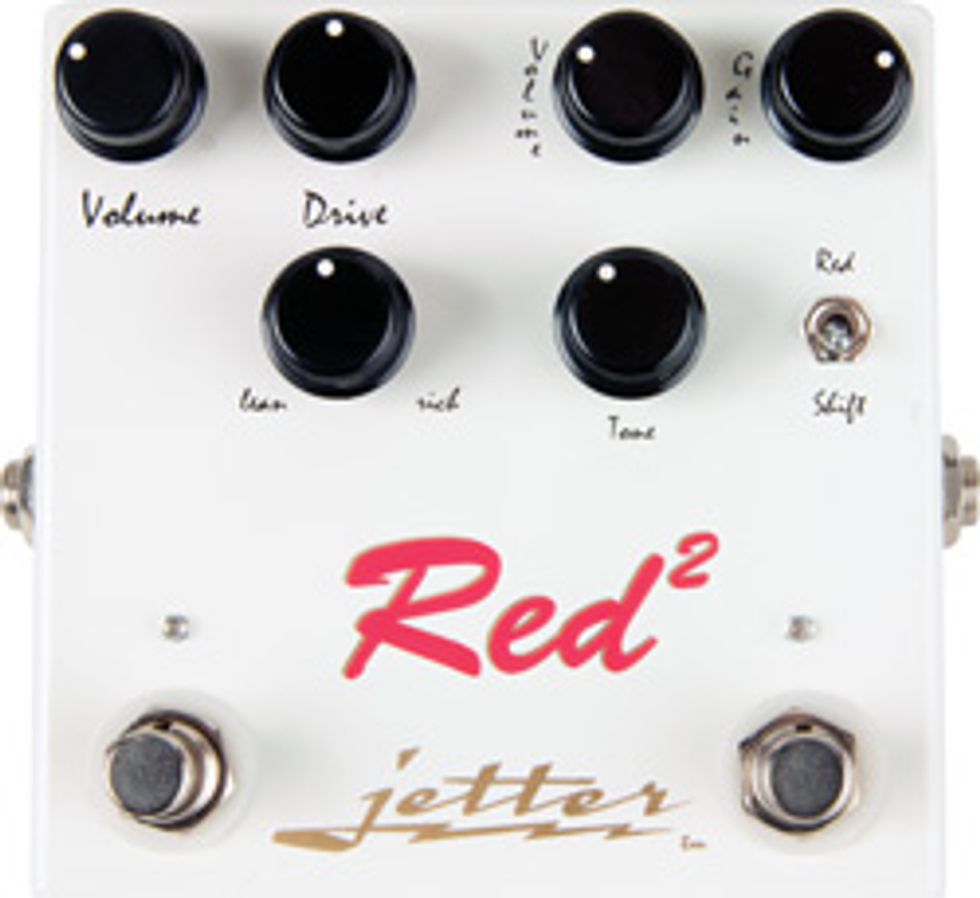
Jetter Red Square
November 2012
READ THE FULL REVIEW
Jetter isn’t even close to the first amp or pedal maker to go after the Holy Grail idea of an all-in-one stompbox that serves up classic British- and American-amp overdrive. In the case of the Red Square, Jetter makes few actual claims of Brit-American tone bliss, but whether Jetter is being coy or just modest, the Red Square goes a long way toward packing both flavors in a single box. The pedal’s Helium circuit is a sweet ticket to blackface-Fender-style overdrive—thickening tone and adding a dose of extra pick sensitivity. The Red Shift side is all Jimmy Page sizzle and searing near-clean tones with a burlier overdrive voice. We found the Red Square as adept at rhythm and lead settings, and the overall harmonic richness was a joy in just about every context. Plus, it’s cheaper than a transatlantic flight and a whole heck of a lot more fun. jettergear.com

Snark SN-10S Tuner
November 2012
READ THE FULL REVIEW
Anyone who has used a Snark headstock tuner knows the thrill of experiencing the speed, accuracy, and value packed into one of those colorful little clip-ons. So when we got our hands on the company’s new pedal tuner and saw the $50 price tag, we were prepared to be thrilled. And the SN-10S did little to let us down. For many, the one complaint against the original Snark was that it felt a little less than rock-solid in construction, but Snark addressed the issue by concealing the SN-10S in a die-cast steel enclosure that’s tough as a brick. But the best part is that the SN-10S actually felt more sensitive than its already-impressive clip-on cousin. Is it wrong to be this excited over a tuner? At just 50 bucks, we’ll settle for cheap thrills. snarktuners.com

Orange Micro Terror
November 2012
READ THE FULL REVIEW
Most traditional Orange amp owners would probably be less than appreciative if you called their rig adorable, but we couldn’t think of a better adjective to describe the new Micro Terror. And after we plugged it in, we weren’t thinking all that much about how it looked anyway. The Micro Terror delivered Goliath tones from a David-ona- crash-diet-sized head. And at 20 watts, the amp proved capable of much, much more than cool practice-amp tones. It’s rich sounding when running at saturation, and brimming with characterful midrange content when you dial it in right. And while you won’t get cathedral-scale headroom out of this little brick, even the clean tones had us doing double takes. At the price of a stompbox, the Micro Terror is inarguably a deal—and one that pays both unlikely and surprising dividends. orangeamps.com
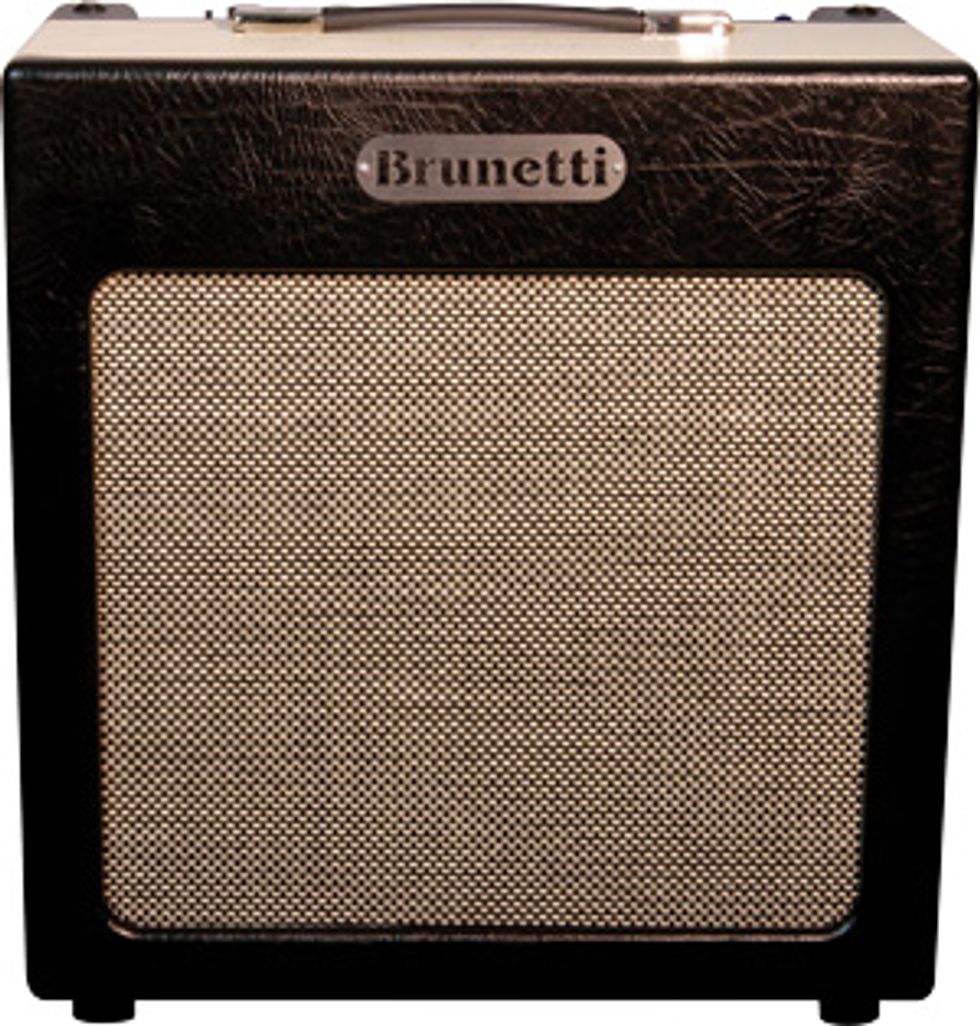
Brunetti Singleman
November 2012
READ THE FULL REVIEW
The little blackface Fenders of old—the Champ, Princeton, and Deluxe—were such beautiful blank slates for guitar players. Part of that agreeable, adaptable, sweet-toned nature was the elegant simplicity of the circuits. And amp-builders were understandably thrilled to find that building a reasonable facsimile of one of these classics was an attainable goal. But that same simplicity has often led us to wonder where else can such a fundamentally sound template take you? The Brunetti Singleman answers that question with style—using a 16-watt, 6V6-powered foundation as a platform for a circuit that includes truly useful tweed, fat, and smooth voicing switches, a mids boost, power-attenuation functions, and a beautifully versatile EQ that enable you to move beyond obvious tweed and blackface tone zones and into territory you can carve out as your own. It’s one handsome-looking amp too, which will make you one stylish guitar slinger on the sonic and fashion fronts. brunetti.it

